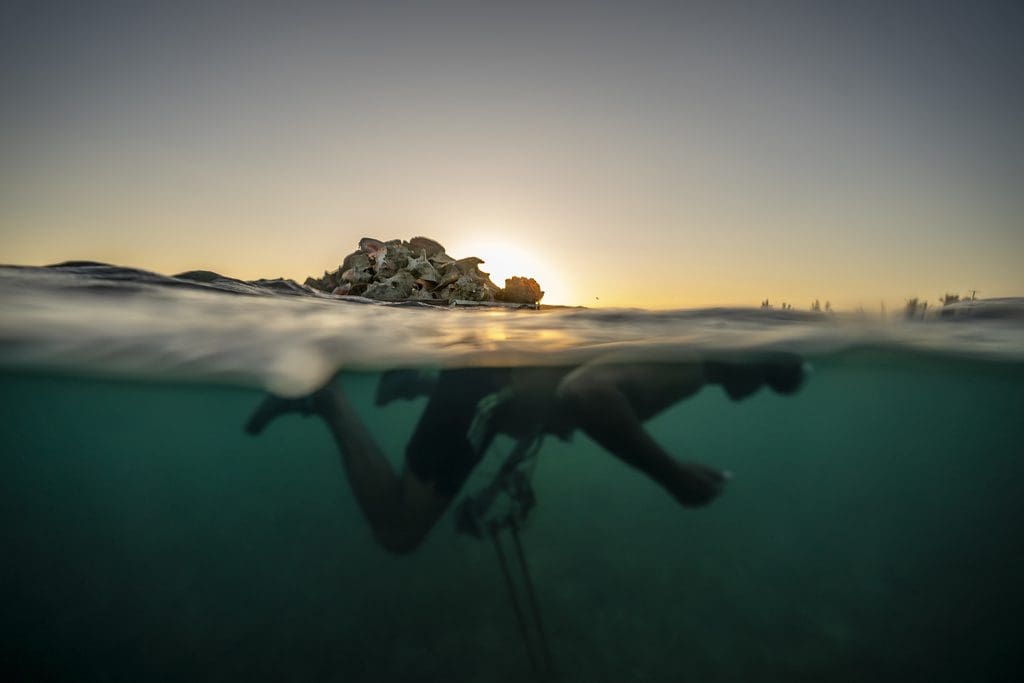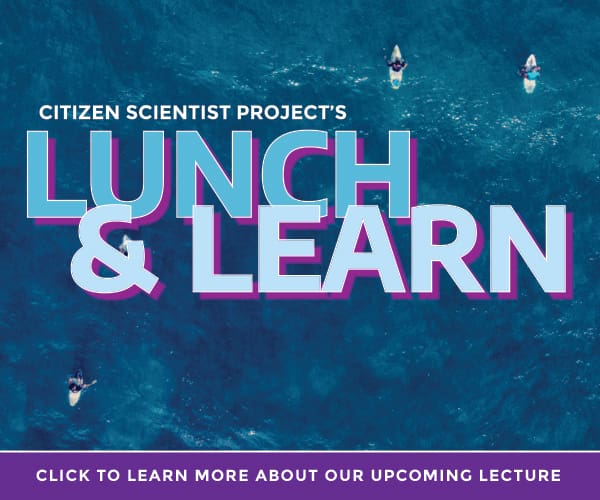BY PATRICK WHITTLE
FREEPORT, Bahamas — Tereha Davis, whose family has fished for conch from waters around the Bahamas for five generations, remembers when she could walk into the water from the beach and pick up the marine snails from the seabed.
But in recent years, Davis, 49, and conch fishers like her have had to go further and further from shore – sometimes as far as 30 miles – to find the mollusks that Bahamians eat fried, stewed, smoked and raw and are a pillar of the island nation’s economy and tourism industry.
Scientists, international conservationists and government officials have sounded the alarm that the conch population is fading due to overfishing, and a food central to Bahamians’ diet and identity could cease to be commercially viable in as little as six years.
“When I was a child, we never had to go that far to get conch,” said Davis, speaking at a Freeport market where she sold her catch. “Without conch, what are we supposed to do?”
Conch’s potential demise reflects the threat overfishing poses around the world to traditional foods. Such losses are among the starkest examples of how overfishing has changed people’s lives – how they work, what they eat, how they define themselves.
The overfishing challenges faced by Bahamians are mirrored in places as disparate as Senegal, where overfishing has taken away white grouper, long the basis for the national dish of thieboudienne, and the Philippines, where it has depleted small fish such as sardines that are used in kinilaw, a raw dish similar to ceviche.
No longer a theoretical threat, overfishing has wiped out once abundant species and taken off the table forever beloved culturally important dishes. And it’s a worsening problem – the United Nations Food and Agriculture Organization has stated that more than a third of the world’s fish stocks are overfished, and the rate of unsustainable fishing is rising.
Governmental organizations and advocacy groups are working to stop illegal, unreported and unregulated fishing that has expedited the loss of species. They blame poaching, poor regulations and lack of enforcement of existing laws. Regulators, such as the National Oceanic and Atmospheric Administration in the U.S., have said cutting down on illegal fishing is critical to prevent losing beloved food options.
The loss of such foods jeopardizes the availability of protein and iron in people’s diets in poor countries and alters the course of culture in rich and poor nations, said Richard Wilk, a professor emeritus in the Indiana University Department of Anthropology who has studied food cultures. Nations that fail to control overfishing run the risk of repeating the mistakes of countries such as Japan, where the herring fishery collapsed in the middle of the 20th century, costing jobs, reducing access to a traditional wedding food and leaving the country dependent on foreign supplies, he said.
But the toll is heaviest in developing nations and poorer communities.
“The way that environmental changes and overfishing affect people and cuisine is different for subsistence fishers, who may end up going hungry, or local marketers, like the women who smoke fish on the beaches in West Africa,” Wilk said.
Support Nonprofit News. Donate Today
Few countries are as synonymous with a seafood as the Bahamas is with conch. Queen conch, the key food species, is a marine snail that reaches up to a foot in length and can live for 30 years. The shells are conical with multiple protruding spines, and all parts except the shell are edible, with a flavor sometimes compared to both clams and salmon.
[read more]
The shellfish appears prominently at the top of the national coat of arms and conch is widely recognized as the national dish. Conch shells and symbols of the shellfish are everywhere: A giant statue of a conch shell greets tourists at Lynden Pindling International Airport in the capital city of Nassau. Dishes, spoons and art made from conch shells are for sale at street markets. Flags, T-shirts and hats depicting conch sell briskly to visitors. Conch shells serve as paperweights, bowls, musical instruments and Christmas ornaments.
While conch can be pricey in the U.S. and elsewhere, it’s so ubiquitous in the Bahamas that finding a filling meal of conch for less than $10 is not difficult. That is less than the price of many meats on the island, and conch is also found for sale at most grocery stores for eating at home. In rural parts of the Bahamas, nearly two-fifths of the population eats conch weekly, according to one 2021 study.
The country of about 400,000 is home to 9,000 conch fishers – fully 2% of the population, and the number appears to be holding steady even as conch declines, according to a study in the journal Fisheries Management and Ecology. The meat of the conch itself is worth millions per year at the docks, and it’s also a key driver of tourism to the islands, in addition to being an important export item to the U.S. and many other countries where conch is a delicacy.
The conchs are often cracked open with a hammer on the beach soon after they’re harvested, the meat swiftly removed and the shells discarded.
—-
Sherica Smith, 44, owns Shabo’s, a popular conch stand on Grand Bahama Island. She too remembers a time when “you could walk out there and get conch.” She motioned to the ocean behind her stand, where people fishing conch now must head to sea in boats to dive for the shellfish.
According to numerous government authorities and conservation agencies, queen conch has declined precipitously in some of the nation’s fishing grounds. A 2011 survey of the Exuma Cays, a critical fishing area, found that the density of adult conch had declined by nearly 91% on the islands’ shelf over a 20-year period, according to documents from the Food and Agriculture Organization of the United Nations. The depletion of conch followed years of heavy nationwide harvesting – fishers who harvested about 1.7 million pounds of conch in the 1970s were up to more than 14 million pounds by 2006, the documents state.
Andrew Kough, a biologist with the Shedd Aquarium who has researched conch in Bahamian waters, said one challenge the shellfish face is the lack of enforcement of existing laws that restrict fishing by foreign vessels. Industrialized fishing fleets from other nations have overexploited some of the areas where conch grow, he said.
Poaching is especially problematic on Cay Sal Bank, an underwater habitat between Cuba, Florida and the Bahamas, Kough said.
Poachers “have been operating under the assumption that they won’t be caught,” Kough said. “Enforcement is extremely challenging out there.”
The Bahamas’ national association with conch is also a large part of what has caused its decline, said Lindy Knowles, senior science officer with Bahamas National Trust, a non-profit that manages national parks. Tourist demand for the shellfish has led to its depletion in many areas of the country, Knowles said.
The demand for conch has made it difficult for the shellfish to reproduce fast enough to sustain the population, Knowles said.
The problem of overfishing is worsened by the warming climate, which has brought unpredictable weather that disrupts and damages conch fishing grounds and habitats. The conchs gather in large groups to feed and breed on seagrass beds, some of which have been severely damaged by storms such as Hurricane Maria in 2017. Herds in those areas have thinned, scientists have said.
The growing acidification of the warming ocean is also a threat to conchs because it can cause their shells to deteriorate. The problem is linked to climate change, and is a growing concern for many kinds of shellfish.
—-
In the Bahamas, conservationists want to learn from mistakes in the U.S., which taught the hard lesson that once conchs disappear, it’s very difficult to bring them back.
Nearly 60 years ago, the once-vibrant Florida conch fishery fell victim to overfishing. Conch was once abundant off the Florida Keys, and Key West still carries the nickname the “Conch Republic.”
Conch harvesting dates to long before the European settlement of Florida, as Indigenous groups fished for the shellfish millennia ago. It grew to become a commercial enterprise, and reached the point of unsustainability in the middle of the 20th century.
Commercial harvesting of conch, which accelerated after World War II, was banned in Florida in 1975, and even recreational taking of conch was stopped a decade later. The state began attempting to rehabilitate the conch population with a research program in the mid-1980s, but it remains off limits to all harvesters.
The loss of Florida conch is one factor that has led to the U.S. becoming the world’s biggest importer of conch meat, and that has in turn put pressure on Bahamian fishers to harvest more. Since the Florida ban, the Bahamian harvest increased from about 4 million pounds in the mid-1970s to more than 8 million pounds in the mid-2010s.
Scientists are still hopeful about the possibility of one day rebuilding Florida’s conch population, but it remains in bad shape, according to reports published by the National Marine Fisheries Service.
One reason conchs have been difficult to restore in Florida is the mollusk’s life cycle. Conchs take three to four years to reach reproductive age, and they’re very sensitive to water quality, sometimes failing to reproduce if conditions are not ideal.
“Once they’re gone, they tend to stay gone,” Kough said.
In the Bahamas, the government has explored new conservation measures, such as stricter rules about minimal harvesting size, to reduce fishing pressure and let conchs reproduce.
The government has also pursued more aggressive enforcement of existing laws. And the Bahamas National Trust is working to equip fishers with tools to help them physically measure conchs to ensure they’re big enough to harvest.
The U.S. is considering listing conch under the Endangered Species Act, which could halt imports of it into the country, the largest importer in the world.
—-
Many fishers of conch, such as Davis, acknowledge that there are less conch than there used to be. But there is also much opposition to the possibility of new restrictions on the fishery. Even the possibility of a closed season draws ire.
“I don’t want to see putting a season on the conch, or banning it,” Davis said. “The government are putting more emphasis on coming down on us. But there’s not so much focus on poachers.”
[/read]


